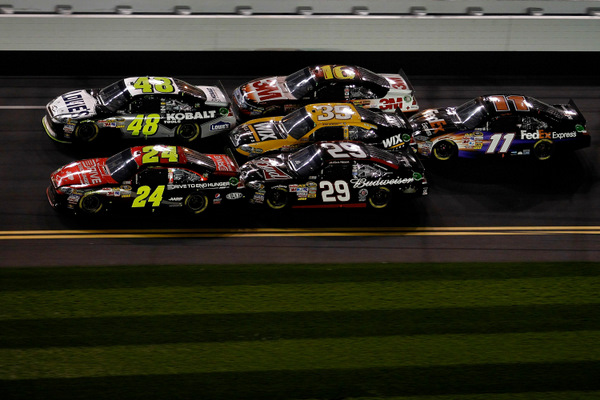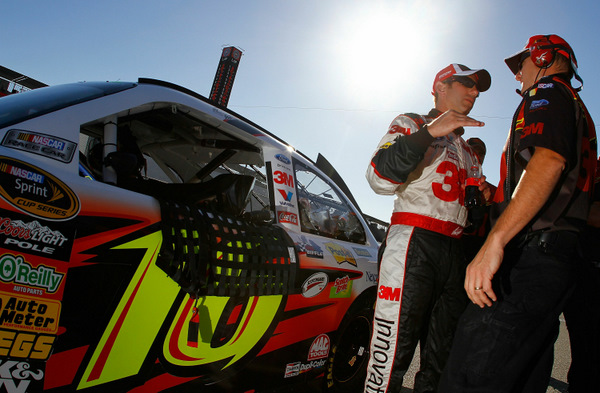And when it stops raining.......

Some two-car drafting packs are better than others, and Jeff Gordon (24)-Kevin Harvick (29) weren't as good together as Harvick and teammate Jeff Burton. But Jimmie Johnson (48)-Greg Biffle (16) might have been just as fast as the two who led into the final laps, Ryan Newman (39)-Denny Hamlin (11). Is this good racing? Sure looks like it. (Photo: Getty Images for NASCAR)
By Mike Mulhern
mikemulhern.net
The biggest effect will likely be on engine durability.
Drivers were hitting rev limiters in Saturday night's Shootout, maybe up to as much as 9200 RPM (Fox' graphics incorrectly showed much higher RPM).
And drivers worry that, since they don't have to back off in the corners, because of this new grippy asphalt, they will be running sustained RPM for all 500 miles, making this race, at 3-1/2 hours, the toughest of all on engines.
The smaller plates should cut top-end RPM by 150 RPM.
Will that be enough to keep these engines together for 500 miles?
Who might be able to run more top-end RPM longer than a rival? Which car maker could have the RPM edge?

Greg Biffle (L) and crew chief Greg Erwin (Photo: Getty Images for NASCAR)
Ford's Greg Erwin, crew chief for Greg Biffle:
"Engine longevity, cycles at top-end…..We know what the life-cycle looks like at the top-end, with valve springs and all that. And we're fairly confident at 8900 to 9000.
"Not as confident at 9100.
"And not very happy with 9200 at all.
"So cutting RPM by 100 to 150 might be the window….
"Closing off the front ends and putting them a little closer to their temperature and pressure threshold – that's an attempt to try to break apart the two-car packs.
"It won't break them apart permanently, but it will probably make it to where the trailing car has to break out just a bit more often, and not be able to keep the flow-field around the two cars quite as long."
The benchmark here so far for holding a two-car draft together was the Jeff Burton-Kevin Harvick teammate pack Saturday night – 25 laps without having swap spots. "We knew we could do that….but I don't think they knew we could do that," Burton said.
NASCAR Robin Pemberton says the two-car packs need several laps to get the momentum up to hit maximum speed, and he hopes the over-heating element the changes add to this equation will keep teams from building that momentum.
That may be optimistic.
Erwin says it may only take half a lap for any two-car draft to hit max speed.
"A quarter of a lap to half a lap….to get to a guy and locked on to his rear bumper," Erwin says. "Then you can see that really start to pull away from whatever traffic is around.
"The fastest combination is two cars, with no other cars around them."
A two-car breakaway.
Then at the end of the Shootout, it was a four-car pack….or rather two two-car packs with maybe half a car-length between the two. And behind that pack, another four-car pack trying to catchup.
Biffle was part of that second pack, pushing Jimmie Johnson.
"What happened to us – we had a real good run on the leaders, but the closing rate was so high that Jimmie had to make a pretty evasive move to the bottom of the track," Erwin said. "And as the pushing car, when you're not really able to time that just right, we wound up being away from Jimmie for just a brief second – and that's all it took for us to back up."
Another oddity, according to drivers, some two-car combinations were decidedly slower than others, even among team cars. Jeff Burton saw that, running much quicker with Harvick but then unable to do much with third teammate Clint Bowyer. Likewise Harvick could push Burton very fast, but when Harvick had to try to push Jeff Gordon that two-car lineup was much slower. Denny Hamlin reported the same phenomenon.
"We don't know exactly why that happens," Erwin said. "Could be the (engine) cowl (induction), could be under the car, could be the ductwork, could be the side-skirts, could be a dozen things.
"We just can't pinpoint it."
Dale Earnhardt Jr. says NASCAR should be going with larger restrictor plates, to boost speeds and force drivers to change their styles.
Jeff Gordon says NASCAR should be going with taller rear spoiler, to use drag to cut speeds.
Greg Biffle says NASCAR should be going with smaller rear spoilers or radically less angle, maybe 35 degrees instead of the standard 70, to make the cars harder to drive.
Jimmie Johnson says NASCAR may go back to a larger plate after Thursday's races.
It may seem strange that any sport can get to within a couple days of its biggest event and not yet have the rules down pat.
First there was the December test here.
Then the January test.
Teams have been running everything through their expensive computer simulation programs.
And then came Saturday night's Shootout, with its lightning fast two-car packs, one of the most unpredictable races ever here, drivers to a man said.
Then NASCAR said 206 mph was too fast, and officials began mulling over options.
Earnhardt says a big test later this spring might be needed to figure out some dramatically different options. And he says bluntly he prefers the big pack rather than two-car packs of mix-and-match where each man has to do some much politicking and thinking.
But Johnson says he liked Saturday's Shootout precisely because it was so unexpected that drivers had to think hard about how to run the 187 miles.
With all that, plus the track idled Monday and Tuesday, and with Sunday blocked off for traditional but quite boring and uneventful better-of-two-lap qualifying, drivers arrived here Wednesday morning in a long drizzle that threatened to idle the cars even longer……well, it doesn't look like NASCAR has blocked out this week's limited time very effectively….with the turn of events.
Dale Jarrett: the three-time Daytona 500 and Winston Cup champion takes offense at some fellow ESPN opinionators who hint they think NASCAR may be rigged like professional wrestling (Photo: Getty Images for NASCAR)
Those comments on a Tuesday ESPN show that questioned Dale Earnhardt Jr.'s Daytona 500 pole winning run here and this sport's integrity in general struck a harsh cord with Dale Jarrett.
Jarrett, a three-time Daytona 500 winner and the 1999 Winston Cup tour champion, put it bluntly: "It pisses me off.
"It pisses me off that somebody thinks that, from being inside…..knowing how hard, and for so many years, that I and these guys worked on our race cars
"Dale Earnhardt Jr. is in a very good car here, and he always run well here when you give him good equipment. In fact he's my pick to win the Daytona 500. Because it's the 10th anniversary of his father's death? No. It doesn't have anything to do with that.
"It just aggravates you that that perception is out there.
"It's unfair to the competitors and those who work their tales off for someone to say that. It's very unfortunate.
"We have a really good sport with a lot of really good people and a lot of integrity, and to have a little bit of it questioned is unfortunate."
ESPN's Rich Feinberg, who heads the network's racing operations, concedes that having criticism such as on Tuesday's Pardon the Interruption does make it more difficult to push his own agenda of promoting NASCAR racing as a brand item.
"It does sometimes present challenges," Feinberg said.
"That's a show of opinion. And they entitled to their opinion….hopefully they present it with responsibility, and in a dignified way. It's an Emmy-winning show for the most part.
"They're entitled to their opinion. You're entitled to your opinion. And I'm entitled to my opinion, and I disagree with what I was told he said. And I assure you that ESPN doesn't agree with his opinion yesterday.
"But that's the nature of commentary, and not all the time are we going to get a rosy picture when people are offering their opinions."
Brian Vickers' interview in the current issue of Maxim is wide-open, and one-time teammate Jimmie Johnson, who has also lived in New York City, found the article quite humorous: "I know that Brian," Johnson said with a laugh. "I think he had an off-year and had a chance to pursue a lot of things….and did.
"Brian has always had a unique view of things….and Brian has never lacked for confidence, which came through in the article too."
© 2010-2011 www.mikemulhern.net All rights reserved.
Web site by www.webdesigncarolinas.com







Post new comment